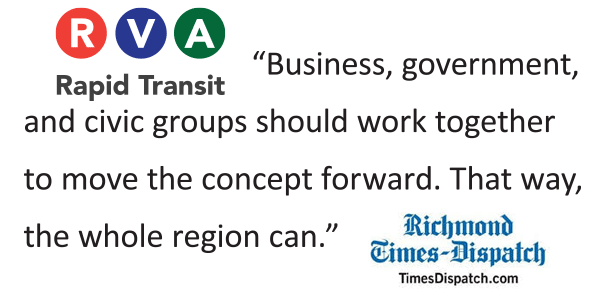RTD editorial endorses area Rapid Transit
On Monday, March 24, the following article ran on the editorial page of the Richmond Times Dispatch:
“So far, this newspaper’s year-long series on creating a more dynamic dominion has focused on education. We turn now to mobility. And while that might seem a change of subject, in one important sense it is not: Mobility entails not just transportation but also social mobility – and nothing fosters social mobility as much as good education does.
In that sense, the past several editorials in the series have discussed how people can move up. Today we consider a different part of the question: how they can move around. That, too, touches on social mobility – at both the individual and the community level. A person’s job prospects are constrained by his range of movement; the fate of neighborhoods and even whole localities can depend on the chosen route for a new highway.
Transportation spending is not the core problem – although the transportation package agreed to during last year’s General Assembly session did address a serious shortcoming in Virginia. Yet as the Brookings Institution points out, since 2000 the U.S. has built enough new lane miles to circle the globe four times. Spending money is easy, at least compared to spending it wisely.
One wise solution for the Richmond region – first pitched by the GRTC five years ago and currently being promoted by a local civic group – is bus rapid transit, or BRT.
BRT is, most commonly, a bus system that enjoys the exclusive use of a given lane. It thereby offers the virtues of light rail – rapid movement along dedicated routes unimpeded by other traffic – without its ruinous expense, which now runs in excess of $100 million per mile. That’s roughly 10 times the cost GRTC cites for a BRT system. And BRT offers the flexibility of traditional bus service – unlike rail, routes can be changed fairly easily – without the aggravation of being stuck in start-stop congestion. If a water main breaks, a bus line can be rerouted with little difficulty. A rail line can’t.
BRT systems also use technology regular bus services don’t, such traffic-signal prioritization, mechanical docking arms, and airport-like status boards at stations that note in real time when the next BRT bus will arrive. Much of the technology is essential to BRT success. Many BRT systems also include “full-feature” stations that include shelters with lighting and even individual seats rather than benches. Those ancillaries are not necessary, but have helped to increase ridership. So has BRT frequency: On many lines, such as the HealthLine in Cleveland, a BRT bus arrives every 10 minutes.
Why would BRT be a good fit for Central Virginia? Cost is one reason. The most tightly packed locality, Richmond, has a population density of about 3,000 people per square mile. Cities with decent metro systems have much higher densities: 27,000 people per square mile in New York; 13,000 in Boston. By contrast, Chesterfield has a population density of fewer than 800 people per square mile. Commuter rail here would be absurdly cost-inefficient.
Yet there remains a considerable need for some form of mass transit – and not, as some suburbanites might think, so poor Richmond residents can find work in the counties. It should be noted that high-skilled jobs are concentrated in the cities.
The Richmond region does lag behind other areas of the country, though. According to a study of the 100 largest metro areas in the country, an average of 69 percent of people in those jurisdictions live near a transit stop. In Richmond, the figure is 31 percent. Richmond-area residents wait 36 percent longer for a transit vehicle than the national average. Barely more than a quarter of this region’s jobs can be reached by transit. When all those factors are combined, the Richmond metro area ranks 92nd out of 100 for transit access to employment.
Another plus: BRT buses can be configured to run on natural gas, multiplying the environmental benefit that comes from reducing the number of cars on the road.
Conservatives might be skeptical of BRT, given their tendency to view public transit as just another form of central planning favored by car-hating environmentalists. Those who feel that way ought to heed Randall O’Toole, a transportation expert who has written extensively in opposition to rail transit. BRT, he says, “can cost less to start, cost less to operate, and move people faster than rail. . . [BRT] would cost-effectively improve transit service for those who cannot drive or choose to use transit.”
At this point, BRT in central Virginia remains largely in the planning stage. Business, government, and civic groups should work together to move the concept forward. That way, the whole region can.”

